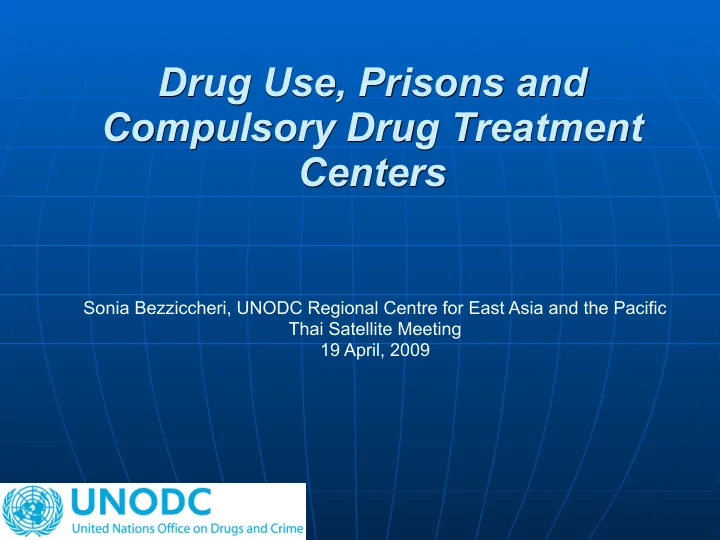

Drug Use, Prisons and Compulsory Drug Treatment Centers Sonia Bezziccheri, UNODC Regional Centre for East Asia and the Pacific Thai Satellite Meeting 19 April, 2009
Background In Thailand, drug offences account for the majority of • people in prison An exponential increase in methamphetamine availability • and use in the last ten years has placed further pressure on Thailand’s prison system In 2005, 65% of people in Thai prisons were on drugs • related charges In 2006, 75% of the 68,000 drug-related arrests were • methamphetamine related 2
Prisons are overcrowded The large numbers of drug users in prison has led to severe overcrowding The National Rehabilitation Act was established in 2002 to divert drug users from prison Drug users considered “patients, not criminals” 3
Treatment Centers Drug users increasingly sent to compulsory drug treatment centers (CDTC) “boot-camps” – there are currently 84 CDTCs in Thailand 75% of these centers are managed by the military or police 4
Number of compulsory drug treatment centres is increasing Year Thailand 2004 35 CDTCs 2005 49 CDTCs 2008 84 CDTCs 5
A regional issue Incarceration of drug dependent people in compulsory drug treatment centers is common CDTCs Cambodia China Lao Myanmar Thailand Viet PDR Nam Number of 14 516 (as 5 26 (major) 84 109 CDTC repor and 40 ted) (minor) Population Unknown 140,000 Unknown 1,492 2,358 Approx. in (adults 100,00 CDTC ) 0 3,500 (youth ) 6
Implications for individual and public health A history of incarceration has been associated with several negative health outcomes: STIs including syphilis, herpes and HIV Mental health issues, skin infections TB Hepatitis B and C AIDS and TB are reportedly the major cause of death 7
Why? Risk behaviours in prisons and CDTCs are prevalent: Unprotected sex Tattooing Injecting drug use Penile modification “Fung Muk” 8
The Facts Overcrowding - Limited availability of condoms - No availability of sterile needles/ - syringes which leads to frequent sharing of equipment Under staffed and unqualified staff - Modest budget for HIV/AIDS services - Basic primary health needs are unmet - 9
Discussion A policy of confinement of drug users in either prison or a CDTC is common in South East Asia: CDTCs are present in every country in the - SE Asia , and number is increasing in most countries Lack of research on effectiveness/ - consequences of this policy Relapse is high - when reported - 10
Discussion cont’ No adequate provision of evidence based drug treatment for either opiate or methamphetamine dependence including harm reduction services 11
Human Rights and Principles of Drug Treatment Current approaches of confinement of drug users contravene: 1. the UN Covenants on Human Rights: The Right to the Highest Attainable Standard of Physical and Mental Health 2. WHO/UNODC Principles of Drug Dependence Treatment 12
The concerns No evidence that the drug treatment centers are in any way effective as relapse rates are very high All necessary steps to prevent, treat and control epidemics (HIV particularly) are currently not being taken prisons and compulsory treatment centers 13
Universal Access or Access: Denied? What are the human, economic and social costs of the CDTCs approach for individual, the community, the state? What are the public health risks for confined drug users and the wider society? 14
Recommendations Research on health risks and vulnerability in 1. both prisons and CDTCs is needed Evaluation on effectiveness of CDTCs is 2. necessary Alternatives to imprisonment and 3. confinement, including increased access to low threshold, voluntary, community and evidence based drug treatment options; and a comprehensive HIV/AIDS package of interventions for drug users 15
Recommendations 4.Protect human rights of drug users 5. Cease long period of detention without trial and without access to health care especially for drug dependent people 6. Involve NGOs/civil society/families/ affected community in the research; design, and implementation of responses 16
Tools: 17
Thank you www.unodc.un.or.th/drugsandhiv/ 18
Recommend
More recommend